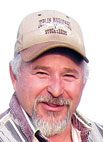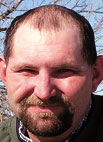
Jimmie Chastain of Dunnegan, Mo., in Polk County grew up on a dairy farm, which also had some beef cows and feeder pigs, milking jerseys also show animals for 4-H. He’s spent his whole life as a producer. Today he owns 186 acres of his own and leases another 160 acres. In 2012 he owned 60 momma cows plus calves and a few bulls. Jimmie downsized that year like a lot of other producers because of the drought.
Jimmie’s base is Charolais but he has a lot of other breeds in the mix mostly beef such as Limousin, Angus, Hereford, Simmental and Gelbvieh. There are a few Jersey still on the property but they are of sentimental value for him and his mother.
Jimmie has spent the last 28 years working for MoDot. The Chastain family was chosen as the 2005 Extension Council Polk County Farm Family through Farm Bureau at the Missouri State Fair. Jimmie thought that was a special honor for his family.
Jimmie starting doing what he calls custom hay work in 1990. He has learned much over the years. Custom hay work allows Jimmie to produce high quality hay for repeat buyers. He wanted to build a reputation for quality hay. Jimmie then set out on a mission to learn how to produce high quality hay.
Jimmie learned that there are many variables. Testing soil, adding fertilizers, over seeding and reseeding are the initial phases and dealing with the soil and crops are part of the first steps. Jimmie works with the leased landowners to determine the best practices for soil condition and hay production. He lets them know that the better the production capability, the better the share opportunity for them.
Next is dealing with the actual hay production. Jimmie learned about size of hay bales. He learned how the larger the bale, the less percentage of lost hay through damage. Jimmie also discovered that the denser the bale, the tighter it could be wrapped and the less the bale would squat and less ground rot. The bale would hold its’ shape, meaning less bales lost due to falling apart when moving. There would be less internal damage because wind and water would have less ability to penetrate.
Next is the cutting and wrapping. When Jimmie first stepped up to his new (used) 2005 Case Baler it had net wrap capabilities. He had never used net wrap so he continued to use the twine option. He was having problems because the person had never used twine in the baler and the paint hadn’t been worn off. The guys where he bought it told him he would have fewer problems with the net wrap. He thought the net wrap was more expensive. They tried to explain to him that the net wrap would save him more in labor and gas than it cost. Jimmie wasn’t an easy sell but since he was having so many problems and he had his back to the wall, he decided to try the net wrap. He couldn’t believe how much faster it was to use, a third of the time with the net wrap over the twine. Down the road the difference in the bales in storage was night and day.
Jimmie learned to stack his bales of similar sizes end-to-end, on a slope running, down hill north to south. He also spaces the rows approximately 3’. You can see when he moves a bale that the bale behind it looks fresh and fairly unscathed by the weather. The thickness of damage on his bales is less than 2” as opposed to average of 4”. He credits that to the density of his bales which is achieved by his bigger rake. He uses a 27’ rake which gives him 1/3 less rounds and more even windrows. This way he has more volume of hay for the better density in the bale.
Jimmie must be doing something right even with the variables mother nature throws into the mix. Last year, even with the drought he produced approximately 1,600 68” tall bales, which weigh approximately 1,100 pounds. Most of those went to repeat customers. Jimmie meets with all of his existing customers and gets their orders for the current year to make sure he can meet their needs first then he will start selling to others. He has a turn-key operation that is producing high quality hay that is worth the price he is asking. That’s what his customers must think because they keep coming back for more.







